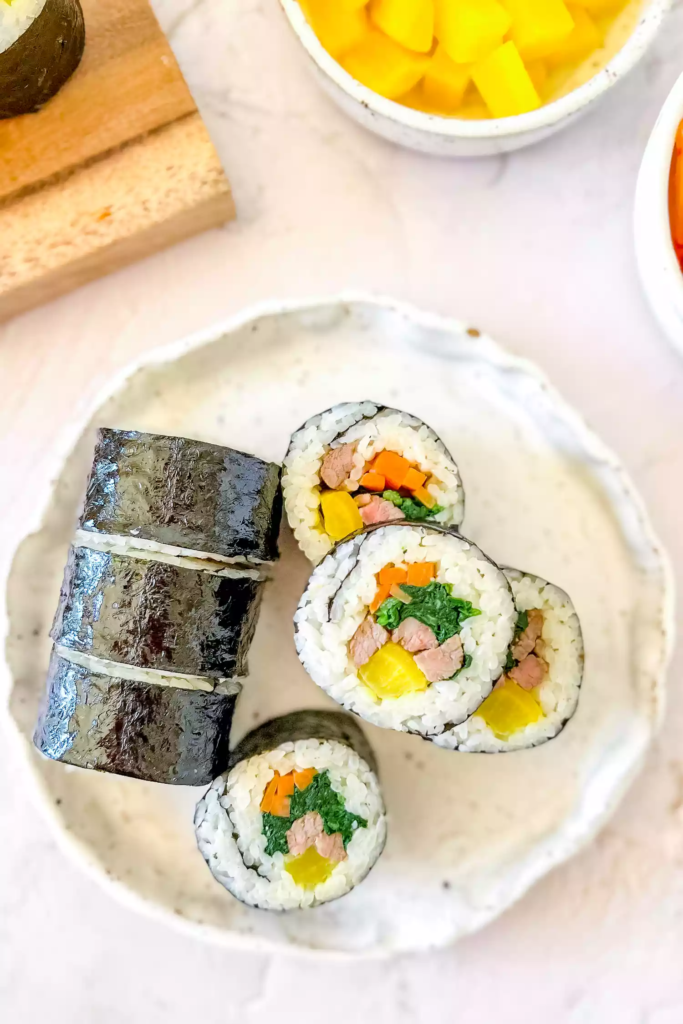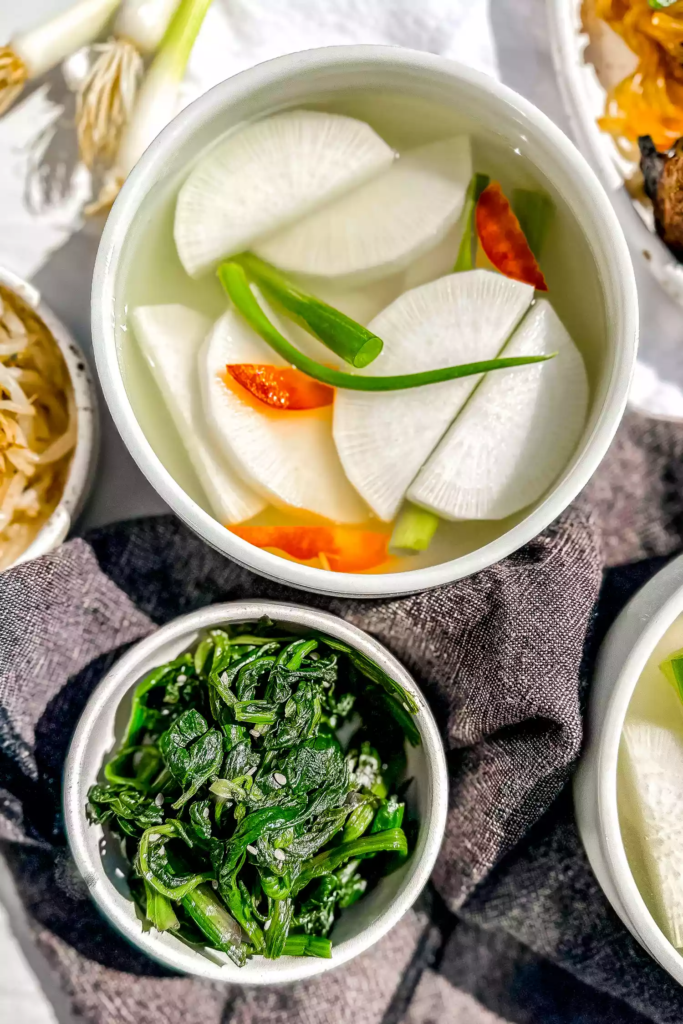Classic Kimbap (Korean Seaweed Rice Roll)

Classic Kimbap (Korean Seaweed Rice Roll)
- Total Time: 45 minutes
Description
Kimbap, sometimes spelled gimbap, is a rice, meat—usually beef—and vegetables rolled in roasted seaweed. During my childhood, when we took family road trips in our VW Hatchback, my mom would always pack kimbap in a huge Tupperware container and put it in our old Igloo cooler, along with bottles of Coke. We never stopped at gas stations or restaurants for food. We pulled over at rest stops, filled our bellies with kimbap and a Coke, and we were set!
Unknown Origins, Delicious Bite
For centuries, Koreans have rolled bap (“rice” in Korean) and banchan (Korean side dishes) in gim (“dried seaweed” in Korean and sometimes spelled kim). What goes inside the roll has always varied. It’s the most colorful and delicious bite of food.
Is this the origin of kimbap? Or perhaps it evolve during the Japanese occupation of Korea in the first half of the 1900s, eventually becoming the version here, often considered the classic kimbap. However kimbap came about, it is one of the most popular Korean foods, often part of a traditional packed lunch called dosirak, picnic, snack, or travel food.
Classic Kimbap Ingredients
Kimbap uses sheets of roasted seaweed—the packaging is sometimes labeled as nori. The rice is always seasoned with sesame oil, and popular filling ingredients include cooked carrots, cucumbers, strips of cooked eggs, a protein such as steak or spam, and fresh or pickled vegetables, like danmuji. It’s a perfect balance of sweet and savory flavors. You won’t even need a dipping sauce.
What Is Danmuji?
Danmuji is a bright yellow pickled daikon radish. The pickle brine has rice vinegar, sugar, seasonings, and turmeric, for an iconic yellow color. It is poured over daikon sliced into rounds, sticks, or even left whole. This bright, acidic, sweet pickle is popular as a banchan or as an ingredient in kimbap.
You can find danmuji in most Asian markets. I buy it at my local Hmart. It is sold in refrigerated packages, whole, sliced into rounds, or cut in long strips, specifically for kimbap. Once opened, leftover danmuji will keep for up to 2 weeks. Transfer it into an airtight container with its original brine and keep it refrigerated.
Ingredients
6 ounces skirt steak or sirloin beef, cut into 3 x 1/4-inch strips
2 teaspoons soy sauce
1 teaspoon rice vinegar
1 teaspoon sugar
1 clove garlic, grated
1 teaspoon vegetable oil
For the rice
4 cups freshly cooked medium-grain white rice
2 teaspoons sesame oil
1/2 teaspoon kosher salt
For the spinach
8 ounces spinach leaves, washed
2 teaspoons sesame oil
1/4 teaspoon kosher salt
For the carrots
1 teaspoon vegetable oil
1 large carrot, peeled and cut into 1/8-inch-wide matchsticks
Pinch kosher salt
For the kimbap
6 (1/4-inch wide) strips danmuji (yellow pickled radish)
6 (about 8 x 8-inch) sheets gim (roasted seaweed)
Sesame oil, for brushing the kimbap
Instructions
Marinate the beef:
In a medium bowl, add the steak, soy sauce, rice vinegar, sugar, and garlic. Mix well and cover with plastic wrap. Set aside to marinate while you prepare the other ingredients.
Season the rice:
In a large bowl, add the freshly cooked rice, sesame oil, and salt. Mix with a large spoon until the rice is evenly coated in the sesame oil. Set aside to cool.
Cook the spinach:
Bring a medium pot of water to a boil over high heat. Fill a large bowl with ice water and set it next to the stovetop. Blanch the spinach in the boiling water for about 15 seconds. Use tongs to transfer the spinach into the ice water to stop the cooking. Once cooled, use your hands to squeeze out as much water as possible. Transfer it into a medium bowl and stir in the sesame oil and salt. Place the seasoned spinach on a large plate.
Cook the carrots:
Heat a large pan with 1 teaspoon vegetable oil over medium-high heat. Sauté the carrots for about 1 minute until a little tender. It will not be soft and cooked through. Stir in a pinch of salt. Place the cooked carrots next to the spinach.
Cook the beef:
Set the same pan used to cook the carrots over medium-high heat and add 1 teaspoon vegetable oil. Sauté the marinated beef until cooked through, about 4 minutes. Place the cooked beef next to the spinach and carrots.
Assemble the kimbap:
You can set the strips of danmuji on the same large plate with the fillings. Fill a small bowl of water for dipping your fingers into. Having all the ingredients ready and together will help make assembling the kimbap much easier.
Place a sheet of gim, shiny side-down, on the rolling mat. Use your fingers to spread about 3/4 cup of rice evenly on top of the seaweed, leaving about an inch border uncovered at the top. Lightly dampen your fingers with water to prevent the rice from sticking to them. Dip a finger into the water and lightly dampen the inch border of seaweed. This will help seal it after you roll it.
Add the fillings:
Place about one sixth of the prepared carrots, spinach, beef, and danmuji on the center of the rice—they will lay in a strip from left to right.
Roll the kimbap:
Lift the end of the rolling mat closest to you to fold the gim over the filling, squeezing gently and evenly. Tuck the filling in with your fingers and continue rolling and squeezing until you reach the end of the roll. Pull the end of the mat out and above the roll. Press into the dampened border to seal it, seam-side down.
Brush the outside of the roll with a little sesame oil.
Cut and serve the kimbap:
Roll the remaining kimbap. The gim will become more pliable as it sits, making it easier to cut. Use a sharp knife to cut the kimbap into 6 to 8 pieces. Serve at room temperature.
Kimbap is best served soon after making. In the unlikely event that you have leftovers, store in an airtight container with parchment between each layer. Allow them to come to room temperature before eating; otherwise, the rice will be hard. My mom used to dip leftover kimbap in pajeon batter and pan fry in oil for a treat!
Notes
N/A
- Prep Time: 40 mins
- Cook Time: 5 mins






